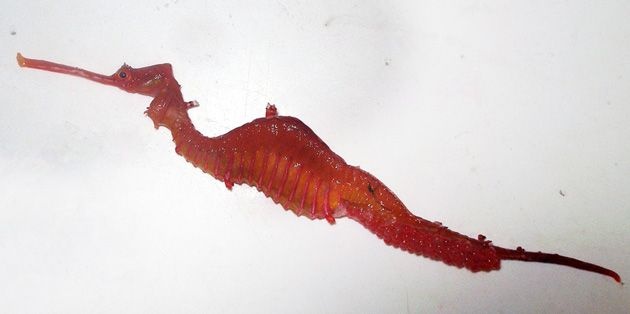The world of seadragons just got a lot more colorful. Researchers have discovered a new species of the small fish for the first time in 150 years, and this vibrant ruby red creature has scientists very excited.
“All this time we thought that there were only two species,” marine biologist Nerida Wilson of the Western Australia Museum said in a press release. “Suddenly, there is a third species! If we can overlook such a charismatic new species for so long, we definitely have many more exciting discoveries awaiting us in the oceans.”
The new discovery, described this week in the journal Royal Society Open Science, was made while scientists at Scripps Institution of Oceanography at the University of California at San Diego were analyzing tissue samples from the museum taken in 2007. They noticed the DNA sequence didn’t match that of other seadragons, but the real shocker came when the researchers requested the full specimen as well as photographs taken after its capture — and saw a fresh, new look for a seadragon.
Seadragons are closely related to seahorses and pipefish, and are only found off southern Australia. National Geographic: “Sea dragons have very long, thin snouts; slender trunks covered in bony rings; and thin tails which, unlike their seahorse cousins, cannot be used for gripping. They have small, transparent dorsal and pectoral fins that propel and steer them awkwardly through the water, but they seem quite content to tumble and drift in the current like seaweed. … Sea dragons survive on tiny crustaceans such as mysids, or sea lice. It is not known if they are preyed upon by other animals.”
The newly discovered ruby seadragon, or Phyllopteryx dewysea, looks very different than leafy seadragons, whose color ranges from brown to yellow, or common seadragons, which can have purple hues. The researchers believe that, because of the animal’s dark red shade, it lives in deeper water where the color can be used as camouflage.
Since the initial finding, scientists have unearthed three other ruby seadragon specimens, including one from 1919. “We’re now in a golden age of taxonomy and these powerful DNA tools are making it possible for more new species than ever to be discovered,” Greg Rouse of Scripps Oceanography, one of the study’s authors, said in a press release. “That such large charismatic marine species are still being found is evidence that there is still much to be done. This latest finding provides further proof of the value of scientific collections and museum holdings.”
Since the seadragons have been in decline since the early 1990s, the Australian government has tried to protect them. Researchers now hope for an expedition to find ruby seadragons in the wild.
“The discovery provides a spectacular example of the surprises still hidden in our oceans, even in relatively shallow waters,” the researchers wrote.



